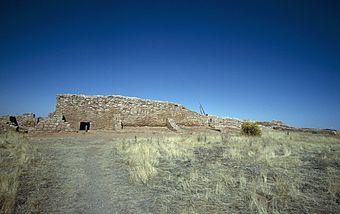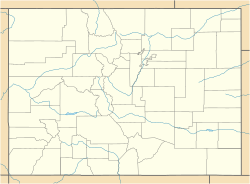Lowry Pueblo facts for kids
|
Lowry Ruin
|
|

Lowry Pueblo
|
|
| Location | Montezuma County, Colorado, USA |
|---|---|
| Nearest city | Pleasant View, Colorado |
| Area | 3 acres (1.2 ha) |
| NRHP reference No. | 66000253 |
Quick facts for kids Significant dates |
|
| Added to NRHP | October 15, 1966 |
| Designated NHL | July 19, 1964 |
The Lowry Pueblo is an ancient village site in Canyons of the Ancients National Monument near Pleasant View, Colorado, United States. It was built by the Ancestral Puebloans, a group of Native American people. This pueblo was constructed around 1060 AD. About 40 to 100 people lived here at one time for about 165 years. Lowry Pueblo is one of the northernmost sites connected to the Puebloan cultures. It was recognized as a National Historic Landmark in 1964 because of its importance.
Exploring Lowry Pueblo
Lowry Pueblo is located about 45 miles (72 km) northwest of Cortez, Colorado. It's also about 100 miles (160 km) north of Chaco Canyon. Chaco Canyon was a very important center for the Ancestral Puebloan culture. The pueblo was named after George Lowry, an early settler in the area.
Life at the Pueblo
Scientists believe Lowry Pueblo started as a small community. It had only a few rooms at first. But it also had a large building called a great kiva. A kiva is a special room used for ceremonies and community gatherings. This suggests the pueblo was a central meeting place for people living in nearby scattered homes. Later, more people moved to the area and the settlement grew.
The people who lived at Lowry Pueblo were farmers. They grew crops to feed themselves. They also hunted small animals for food. These skilled people made beautiful pottery with detailed decorations. They also wove cotton, which they got through trade with other groups. The last time people lived at Lowry Pueblo was in the early 13th century.
Discovering the Past
Lowry Pueblo was first explored by archaeologists. Paul Sidney Martin from the Field Museum of Natural History in Chicago led these digs. He worked there during the summers from 1930 to 1936.
Later, in 1965, the Bureau of Land Management (BLM) took over care of the site. They worked with the University of Colorado for two years. Their goal was to make the ruins stable and protect them. Some parts of the ruins had become buried over time. In 2000, Lowry Pueblo became part of the Canyons of the Ancients National Monument. This helps protect the site for future generations to learn from.





